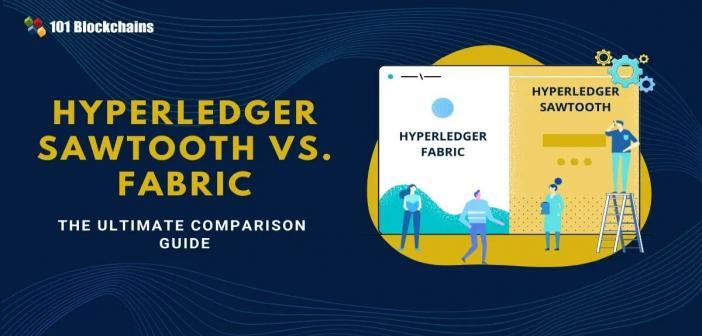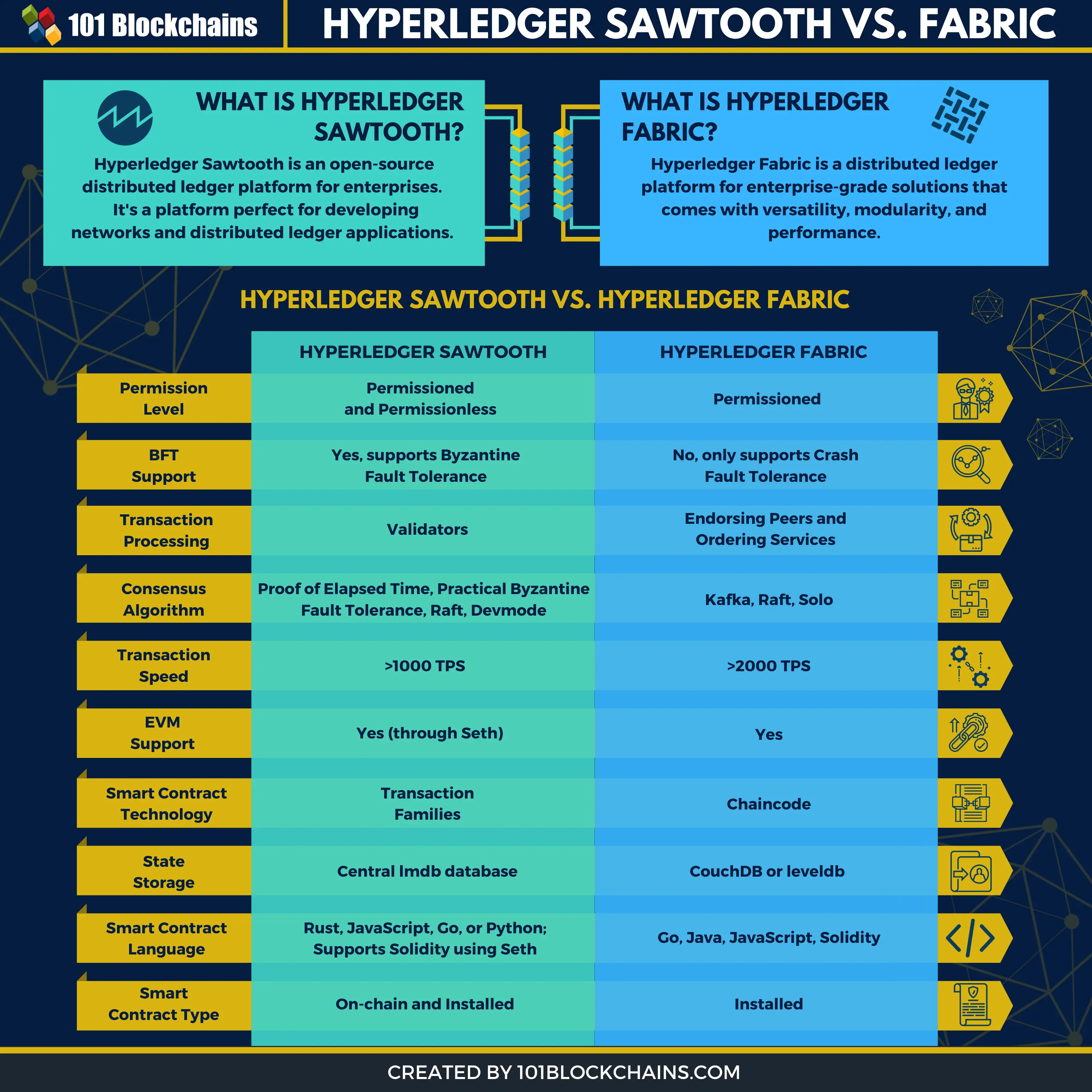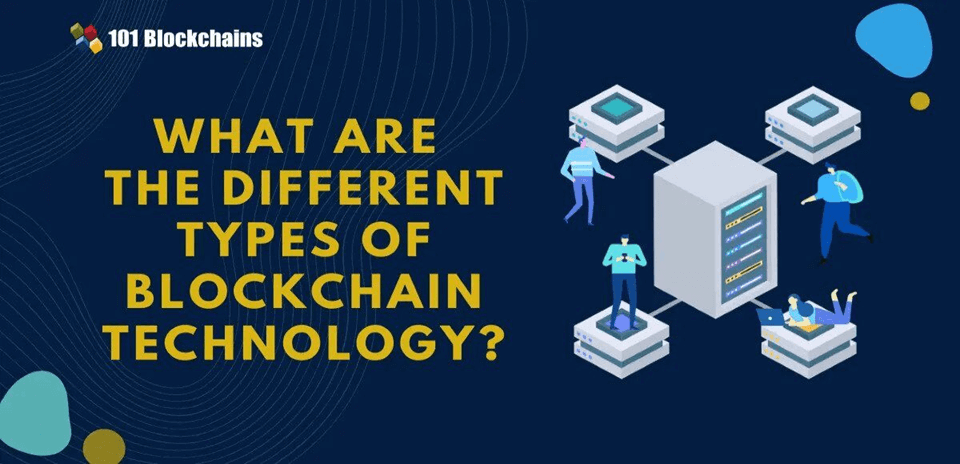Learn how blockchain truly works, master key definitions, and uncover what makes smart contracts so "smart." Dive into the fundamentals, gain valuable insights, and start your blockchain journey today!

- Reviews
Hasib Anwar
- on July 20, 2021
Hyperledger Sawtooth Vs. Fabric: How Are They Different?
Fabric and Sawtooth are two of the most widely used blockchain projects. Here, we will compare Hyperledger Sawtooth vs Fabric and understand their fundamental differences and similarities.
Hyperledger blockchain is one of the popular projects on the market right now. Hyperledger Fabric and Hyperledger Sawtooth are two platforms that offer the best of the best output for enterprises. That’s why there’s always a popular debate on Hyperledger Sawtooth vs Fabric. Many of you also think that both of the platforms are more or less the same. But that’s not the real case. In reality, there are some distinct differences between them, and today we’ll talk about them as well. Hyperledger Fabric seems to be a bit more on the popular side, but both of the platforms have their special use cases. Anyhow, enough with the chit-chat, let’s start the comparison of Hyperledger Sawtooth vs Fabric.
Want to learn the basic and advanced concepts of Blockchain and Hyperledger Fabric? Enroll Now: Getting Started with Hyperledger Fabric Course
What Is Hyperledger Sawtooth?
First of all, we’ll start with a little introduction to both of the platforms to clear things up for you a bit. Hyperledger Sawtooth is one of the major open-source projects of the consortium Hyperledger. In reality, it does have some similarities with Hyperledger Fabric. However, it’s more suited for developing decentralized applications or platforms.
More so, the design comes with a user-friendly approach and flawless performance just for the sake of enterprise usage. Also, they ensure that you have the best smooth experience in the development. Therefore, they kept the development layer totally separated from the main network. That’s why no matter what you do, the core system will always stay unaffected. More so, the increasing amount of resource sharing won’t affect the core system in any way. Thus, making this platform the perfect example of developing applications.
You should keep in mind that the platform does support a wide variety of programming languages. So, that gives you a whole lot of interesting ways to implement blockchain applications or blockchain solutions. You can learn more about the use cases in the Hyperledger Sawtooth tutorial. Actually, Hyperledger does offer very enriching tutorials on Sawtooth just to help developers understand it better. So, if you are interested in learning more about it, you can easily use their Hyperledger sawtooth use cases for that.
Anyhow, let’s see the features of Sawtooth next in this Hyperledger Fabric vs Sawtooth Lake guide.
Please include attribution to 101blockchains.com with this graphic. <a href='https://101blockchains.com/blockchain-infographics/'> <img src='https://101blockchains.com/wp-content/uploads/2020/07/Hyperledger-Sawtooth-vs.-Fabric.png' alt='Hyperledger Sawtooth vs. Fabric='0' /> </a>
Key Features of Hyperledger Sawtooth
-
Easy Application Development
If you check out any Hyperledger Sawtooth example, you’ll see that it’s quite easy to use the platform to develop applications. As you already know, the central core isn’t connected to the application layer. Therefore, it makes it really easy to develop blockchain solutions without affecting the real core itself. More so, there are lots of smart contract development options. Among them, you can choose a preferred programming language and work on that. In reality, you can also ensure that you have smart contract facilities on the platform. You can even make it only a smart contract application as well.
Curious to understand the complete smart contract development lifecycle? Enroll in Smart Contracts Development Course Now!
-
Private and Public Network
Another great feature of Sawtooth is that it offers 2 variants of blockchain for any kind of use case. It means that you will get both permissioned and permissionless access using this platform. In reality, this is something not many platforms can offer. More so, they can offer either permissioned or permissionless, but never both. Companies investing in blockchain can use this feature to get more options and flexibility. So, if in one solution you need permissioned access, then you can go for that. On the other hand, you can also go for permissionless access as well. You can easily see it in any Hyperledger Sawtooth example.
Build your identity as a certified blockchain expert with 101 Blockchains’ Blockchain Certifications designed to provide enhanced career prospects.
-
Permissioning Features
In reality, this platform is more than equipped to help you solve all of the issues of a private blockchain. Thus, for that, it offers a detached permissioning option for every cluster of nodes/devices in the network. The best part is that no node is allowed to leak any sensitive information on the platform to the outside world. Furthermore, you can use the separate permissioning option to assign a different level of clearance for every node.
If a node is not cleared to see specific information about your company, they can never get access to it. In reality, the Hyperledger Sawtooth tutorial does cover this part as well. So, you can get more information there about this.
-
Modular Structure
This is a bit similar to Fabric as both of them offer a modular structure for your enterprise needs. It’s also one of the greatest additions of Sawtooth architecture. In reality, if you study any Hyperledger Sawtooth example, you will see that it’s extremely easy to customize this platform. It’s definitely, on the whole, another level. Hyperledger doesn’t want to limit your innovation. Thus, it makes sure to include as much as blockchain features as it can for you to check out. In reality, if you want to add a completely foreign feature, you can simply just plug it in and use it. Yes, it’s that simple to do.
-
Execution of Parallel Transaction
Another great feature of Sawtooth is that it comes with parallel transaction verification. Do you know what that means? In simple terms, it can verify multiple transactions in parallel to one another. So, it will take the same time to complete hundreds of transactions together. In reality, it gets rid of the massive work pressure from the network and saves a lot of time in the process. Thus, you will see your transaction processing much sooner compared to other platforms. Anyhow, we will take a much closer look into this later on in the Hyperledger Fabric vs Sawtooth Lake comparison section.
Elements of the Hyperledger Sawtooth Architecture
-
The Event System
First comes the event system. This is one of the major necessities of the network. In reality, the event system actually supports the development of events and ensures that they are broadcasted to the nodes. Therefore, using this, many applications can actually subscribe to certain events to help the blockchain run better. More so, this system can relay information to other nodes on the network as well.
-
Sawtooth-Ethereum Integration Project (Seth)
This is actually very important as it lets you use the EVM in Hyperledger Sawtooth without any issues. Do you know that with this feature, you can actually develop a form of interoperability between Ethereum and Sawtooth? Yes, you can actually achieve a form of blockchain interoperability with it. How cool is that, right? Anyhow, you can learn more about using it than their Hyperledger sawtooth use cases.
Excited to learn the basic and advanced concepts of ethereum technology? Enroll Now in The Complete Ethereum Technology Course!
-
Pluggable Consensus Algorithms
In every Hyperledger Sawtooth example, the consensus algorithms are very important things you should notice. Why? Well, Sawtooth offers much more flexibility when it comes to consensus algorithms. More so, it actually comes with a pluggable blockchain protocol option that helps you choose any favorite consensus algorithm.
Do you know what this means? It means that you won’t get stuck working with a single consensus process. Therefore, if you think that a certain consensus will go better with your blockchain solution’s workload, you can go for it. In reality, you can even use multiple consensus algorithms to run multiple features of your solution. For example, you can use the “X” algorithm for smart contracts and the “Y” algorithm for transactions.
Anyhow, some of the consensus algorithms of the platform include –
- Raft
- Devmode
- PoET CFT
- PBFT
Anyhow, we will take a much closer look into this later on in the Hyperledger Fabric vs Sawtooth Lake comparison section. In reality, there are some interesting differences in this part of the two platforms.
Develop your career as a Blockchain Consultant. Start your Blockchain Consultant Learning Path today!
-
Transaction Family Models
When you study the Hyperledger Sawtooth example, you will see that the architecture offers some transaction families. In reality, the network actually operates using these families. Many Hyperledger sawtooth use cases use transaction families.
Anyhow, Sawtooth is offering some options for you to get started. So, let’s check them out and see what they each are.
- BlockInfo Transaction Family: In reality, you can use these to store information about blocks.
- Smallbank Transaction Family: You can use Smallbank to test and analyze the performance of your solution.
- Settings Transaction Family: This one will offer you reference models for storing on-chain configuration settings.
- Validator Registry Transaction Family: More so, using the validator registry family, you can add more validators into the network.
- IntegerKey Transaction Family: Want to test deployed ledgers? You can use IntegerKey to test them out.
- XO Transaction Family: This is actually a bit on the fun side. In reality, you can use it to play tic-tac-toe with another node on the network.
- Identity Transaction Family: It will preserve all the permissioning data for validators and even transacting nodes with their public key, thus giving you a digital identity.
Other than these, there are two other transaction families on the platform at the moment –
Seth Transaction Family: This family is extremely necessary as it offers Ethereum Virtual Machine compatibility for the platform. So, using this, you can run smart contracts in Solidity.
Sabre Transaction Family: It’s also another family that will help you run smart contracts. But here, you can run it on a WebAssembly (WASM) virtual machine. In reality, it will help you run the contract on-chain.
Want to get an in-depth understanding of Solidity concepts? Enroll in Solidity Fundamentals Course Now!
What is Hyperledger Fabric?
Hyperledger Fabric is another popular open-source distributed ledger system under Hyperledger – an enterprise blockchain consortium. In reality, Hyperledger always wants a collaborative environment for their projects. Therefore, all of their projects are the result of the collaboration of different high-end enterprise companies.
For instance, Hyperledger Fabric architecture is actually a collaboration between Hyperledger and IBM. Anyhow, just like all other platforms in the market, Fabric comes with its own share of protocols, standards, consensus, APIs, ledger systems, smart contracts, and so on.
But you will see that this platform is a bit different as well. The most prominent difference is that this platform is not public but rather permissioned. So, it’s mostly suited for enterprise needs. Any public domain can’t use this platform for its blockchain solutions. Also, now there is a new version out called Hyperledger Fabric 2.0, which includes many features. Let’s check out the basic benefits of Hyperledger Fabric in the next segment of this Hyperledger Fabric vs Sawtooth Lake guide.
Want to understand the basic and advanced concepts of Hyperledger development? Enroll Now: Hyperledger Fabric Development Course – Intermediate Level
What Are the Benefits of Hyperledger Fabric?
Before we cover the comparison, let’s learn more about the benefits of Hyperledger Fabric from below:
-
Open-Source
First of all, Fabric is a full blockchain open-source project for you to use. Therefore, you won’t have to pay a single dime to use it. More so, Hyperledger already has the files and codes uploaded on GitHub. So, it’s quite easy to access all the codes from that as well. Therefore, if you are a developer or a company with a strong development team, you can just use that to make your blockchain solution. Another great factor of this platform is that it offers all the features without any initial lock-ins. So, use the code, and change it as you please; it’s all up to you and your company.
-
Suitable for Wide-Ranging Industry
Yes, Fabric is suitable for a wide range of industries. There are many Hyperledger Fabric use cases that are suitable for enterprise environments. As a matter of fact, because it’s so popular when it was first released that there are tons of examples for you to check out now. Many high-end enterprise companies are using Fabric as the backbone of their solutions.
So, you have real-life proof that it works and can deliver what it actually promises. But if you want to learn how to use it, you should check out a tutorial or even get a certification that will cover this.
Not sure how to build your career in enterprise blockchains? Enroll Now in How to Build Your Career in Enterprise Blockchains Course
-
Quality Code
The best part about Hyperledger Fabric is that it comes with high-quality of codes. More so, they are very careful about any new updates. When they add any new updates, they review and test out their codes many times to see if they have any issues. Thus, when it comes to Fabric, you can opt for more quality over quantity. If you notice properly, you’ll see that every single Hyperledger project takes a lot of time to go live in the markets. And Fabric is definitely among them. Therefore, you can always expect the best of the best quality codes from this platform.
-
Higher Efficiency
If we start to compare Fabric with other platforms in the markets, you will be surprised to find the result. In reality, Fabric beats every single of them with higher efficiency. More so, the developers of this platform ensure that it can take on a lot of workloads. That’s why it offers more than 2000 transactions per second. But how does it achieve it? Well, the architecture of this platform separates the transaction processes from the ordering services. Therefore, nodes have specific goals to follow, and everything gets distributed among the nodes for that.
-
Modular Design
Another huge benefit of Fabric is that it offers a modular structure for your enterprise blockchain needs. It’s also one of the greatest additions of Fabric architecture. In reality, it adds up a lot of functionality to the system and makes it crazy customizable compared to any other platform in the market. It’s definitely, on the whole, another level. Hyperledger doesn’t want to limit your innovation. Thus, it makes sure to include as many features as it can for you to check out. That’s why you’ll see so many use cases with one single platform in the background. Can you imagine that?
In reality, if you want to add a completely foreign feature, you can simply just plug it in and use it. Yes, it’s that simple to do. We will cover more about this topic later on in the Hyperledger Fabric vs Sawtooth Lake comparison section.
Start your blockchain journey Now with the Enterprise Blockchains Fundamentals
Hyperledger Sawtooth vs Fabric: The Comparison
In reality, many professionals debate the topic of Hyperledger Fabric vs Sawtooth. Well, we can see where the confusion can be, as both of them seem more or less quite similar. But there are some differences that are critical for you to understand. Thus, once you know them, you can use these two platforms where they are most relevant. So, let’s see the final comparison of Hyperledger Fabric vs Sawtooth now!
-
Permission Level
First of all, the permission level in Hyperledger Sawtooth vs Hyperledger Fabric has a massive difference. In reality, Sawtooth supports both permissioned and permissionless network systems. So, there is no restriction there. On the other hand, Hyperledger Fabric architecture only offers permissioned blockchain access. So, it’s exclusively only for enterprise use cases. But other public companies can also use Sawtooth instead of Fabric.
Here’s a guide to permissioned vs permissionless blockchain to help you understand the core differences between these two networks.
-
Consensus Algorithm
Another major difference in Hyperledger Fabric vs Sawtooth comparison is the use of consensus algorithms. At the moment, Sawtooth offers a wide variety of consensus algorithms to choose from. For example, it offers Proof of Elapsed Time, Practical Byzantine Fault Tolerance, Devmode, Raft, and PoET CFT.
On the other hand, Hyperledger Fabric architecture only offers Kafka, Solo, and Raft.
-
Byzantine Fault Tolerance Support
This is one of the major differences between Hyperledger Fabric vs Sawtooth. In reality, Sawtooth supports Byzantine Fault Tolerance, which ensures that your network is safe and secured from any corruption whatsoever. But Hyperledger Fabric architecture only offers Crash Fault Tolerance. So, you won’t get the highest level of fault tolerance in Fabric. Even though CFT is working absolutely fine as of now. Still, Sawtooth is far ahead of Fabric in this term.
-
Smart Contract Technology
In the next point of Hyperledger Sawtooth vs Hyperledger Fabric comparison, we have smart contract technology. In reality, smart contracts are just a form of business logic, so it means you can automate and digitize your business contracts on the network. Therefore, in Sawtooth, the transaction families look after this feature. You will have to use these families to facilitate your business logic. On the other hand, Fabric offers Chaincode for that. This feature handles all kinds of logic execution and asset management.
-
Smart Contract Type
In Hyperledger Fabric, you get an installed version of Chaincode. Do you know what it means? It means that you can’t alter the contract language here. It’s a bit restrictive. But in Sawtooth, you get both installed and on-chain contracts. Thus, it ensures that you can customize your contracts and use your preferred programming language for that. You can learn more about it from the Hyperledger Fabric tutorial. Anyhow, let’s see the next point in this Hyperledger Fabric vs Sawtooth comparison.
-
Supported Smart Contract Language
Smart contract languages are really important when it comes to blockchain platforms. In reality, in Sawtooth, you get a wide range of language support for it. For example, it offers Rust, JavaScript, Go, or Python, and even Solidity using Seth! More so, they are working on introducing more languages as well. But in Fabric, you only get Go, Java, Javascript, and Solidity, which is a bit limiting.
-
Transaction Processing
For this Hyperledger Sawtooth vs Hyperledger Fabric comparison, we are looking into transaction processing methods. In Hyperledger Sawtooth, you will get validators that will look after the transaction process. On the other hand, Fabric endorsing peers and ordering services look after this process. In short, this process makes Hyperledger blockchain projects so efficient in the first place.
-
State Storage
In Sawtooth, the current state of the network is stored in the central lmdb database. But in Fabric, the state storage is leveldb or CouchDB database. In short, this is one of the important aspects of the two platforms. And without state storage, a network can’t function properly. So, if you are a developer, keep this in mind.
-
EVM Support
Hyperledger Sawtooth uses Seth to support Ethereum Virtual Machine. In reality, it’s a huge deal for developers as they can use Solidity for smart contacts now. On the other hand, Fabric recently integrated this new system that allows it to use EVM as well. So, in Hyperledger Sawtooth vs Hyperledger Fabric comparison, both support EVM.
-
Transaction Speed
When it comes to transaction speed, nothing can beat Fabric as of now. In reality, Hyperledger Fabric comes with a different strategy to increase the speed in the network. Thus, it offers more than 2000 transactions per second.
On the other hand, Sawtooth only offers something close to 1000 transactions per second. This is a bit less than Fabric, but it’s more suited for those industries that don’t need a high transaction rate.
Hyperledger Sawtooth vs Fabric Comparison Table
| Hyperledger Sawtooth | Hyperledger Fabric | |
|---|---|---|
| Permission Level | Permissioned and Permissionless | Permissioned |
| BFT Support | Yes, supports Byzantine Fault Tolerance | No, only supports Crash Fault Tolerance |
| Transaction Processing | Validators | Endorsing Peers and Ordering Services |
| Consensus Algorithm | Proof of Elapsed Time, Practical Byzantine Fault Tolerance, Raft, Devmode | Kafka, Raft, Solo |
| Transaction Speed | >1000 TPS | >2000 TPS |
| EVM Support | Yes (through Seth) | Yes |
| Smart Contract Technology | Transaction Families | Chaincode |
| State Storage | Central lmdb database | CouchDB or leveldb |
| Supported Smart Contract Language | Rust, JavaScript, Go, or Python; Supports Solidity using Seth | Go, Java, Javascript, Solidity |
| Smart Contract Type | On-chain and Installed | Installed |
Curious to learn about blockchain implementation and strategy for managing your blockchain projects? Enroll Now in Blockchain Technology – Implementation And Strategy Course!
Final Words
Now that you know everything about Hyperledger Sawtooth vs Fabric, you can make your final call without any issues. As you can see, both of the platforms have their similarities and differences. So, when you want to choose the perfect platform for your solution, you have to look into their technical differences too. Always remember that a perfect platform can enrich your company and increase revenues drastically.
If you need further help in strategizing about the solution, then you should enroll in our getting started with Hyperledger Fabric course now as it will cover everything you need to know about Hyperledger projects.
*Disclaimer: The article should not be taken as, and is not intended to provide any investment advice. Claims made in this article do not constitute investment advice and should not be taken as such. 101 Blockchains shall not be responsible for any loss sustained by any person who relies on this article. Do your own research!







